St. Therese of Lisieux
Generations of Catholics have admired this young saint, called her the "Little Flower", and found in her short life more inspiration for their own lives than in volumes by theologians.
Yet Therese died when she was 24, after having lived as cloistered Carmelite for less than ten years. She never went on missions, never founded a religious order, never performed great works. The only book of hers, published after her death, was an brief edited version of her journal called "Story of a Soul." (Collections of her letters and restored versions of her journals have been published recently.) But within 28 years of her death, the public demand was so great that she was canonized.
Over the years, some modern Catholics have turned away from her because they associate her with over- sentimentalized piety and yet the message she has for us is still as compelling and simple as it was almost a century ago.
Therese was born in France in 1873, the pampered daughter of a mother who had wanted to be a saint and a father who had wanted to be monk. The two had gotten married but determined they would be celibate until a priest told them that was not how God wanted a marriage to work! They must have followed his advice very well because they had nine children. The five children who lived were all daughters who were close all their lives.
Tragedy and loss came quickly to Therese when her mother died of breast cancer when she was four and a half years old. Her sixteen year old sister Pauline became her second mother -- which made the second loss even worse when Pauline entered the Carmelite convent five years later. A few months later, Therese became so ill with a fever that people thought she was dying.
The worst part of it for Therese was all the people sitting around her bed staring at her like, she said, "a string of onions." When Therese saw her sisters praying to statue of Mary in her room, Therese also prayed. She saw Mary smile at her and suddenly she was cured. She tried to keep the grace of the cure secret but people found out and badgered her with questions about what Mary was wearing, what she looked like. When she refused to give in to their curiosity, they passed the story that she had made the whole thing up.
Without realizing it, by the time she was eleven years old she had developed the habit of mental prayer. She would find a place between her bed and the wall and in that solitude think about God, life, eternity.
When her other sisters, Marie and Leonie, left to join religious orders (the Carmelites and Poor Clares, respectively), Therese was left alone with her last sister Celine and her father. Therese tells us that she wanted to be good but that she had an odd way of going about. This spoiled little Queen of her father's wouldn't do housework. She thought if she made the beds she was doing a great favor!
Every time Therese even imagined that someone was criticizing her or didn't appreciate her, she burst into tears. Then she would cry because she had cried! Any inner wall she built to contain her wild emotions crumpled immediately before the tiniest comment.
Therese wanted to enter the Carmelite convent to join Pauline and Marie but how could she convince others that she could handle the rigors of Carmelite life, if she couldn't handle her own emotional outbursts? She had prayed that Jesus would help her but there was no sign of an answer.
On Christmas day in 1886, the fourteen-year-old hurried home from church. In France, young children left their shoes by the hearth at Christmas, and then parents would fill them with gifts. By fourteen, most children outgrew this custom. But her sister Celine didn't want Therese to grow up. So they continued to leave presents in "baby" Therese's shoes.
As she and Celine climbed the stairs to take off their hats, their father's voice rose up from the parlor below. Standing over the shoes, he sighed, "Thank goodness that's the last time we shall have this kind of thing!"
Therese froze, and her sister looked at her helplessly. Celine knew that in a few minutes Therese would be in tears over what her father had said.
But the tantrum never came. Something incredible had happened to Therese. Jesus had come into her heart and done what she could not do herself. He had made her more sensitive to her father's feelings than her own.
She swallowed her tears, walked slowly down the stairs, and exclaimed over the gifts in the shoes, as if she had never heard a word her father said. The following year she entered the convent. In her autobiography she referred to this Christmas as her "conversion."
Therese be known as the Little Flower but she had a will of steel. When the superior of the Carmelite convent refused to take Therese because she was so young, the formerly shy little girl went to the bishop. When the bishop also said no, she decided to go over his head, as well.
Her father and sister took her on a pilgrimage to Rome to try to get her mind off this crazy idea. Therese loved it. It was the one time when being little worked to her advantage! Because she was young and small she could run everywhere, touch relics and tombs without being yelled at. Finally they went for an audience with the Pope. They had been forbidden to speak to him but that didn't stop Therese. As soon as she got near him, she begged that he let her enter the Carmelite convent. She had to be carried out by two of the guards!
But the Vicar General who had seen her courage was impressed and soon Therese was admitted to the Carmelite convent that her sisters Pauline and Marie had already joined. Her romantic ideas of convent life and suffering soon met up with reality in a way she had never expected. Her father suffered a series of strokes that left him affected not only physically but mentally. When he began hallucinating and grabbed for a gun as if going into battle, he was taken to an asylum for the insane. Horrified, Therese learned of the humiliation of the father she adored and admired and of the gossip and pity of their so-called friends. As a cloistered nun she couldn't even visit her father.
This began a horrible time of suffering when she experienced such dryness in prayer that she stated "Jesus isn't doing much to keep the conversation going." She was so grief-stricken that she often fell asleep in prayer. She consoled herself by saying that mothers loved children when they lie asleep in their arms so that God must love her when she slept during prayer.
She knew as a Carmelite nun she would never be able to perform great deeds. " Love proves itself by deeds, so how am I to show my love? Great deeds are forbidden me. The only way I can prove my love is by scattering flowers and these flowers are every little sacrifice, every glance and word, and the doing of the least actions for love." She took every chance to sacrifice, no matter how small it would seem. She smiled at the sisters she didn't like. She ate everything she was given without complaining -- so that she was often given the worst leftovers. One time she was accused of breaking a vase when she was not at fault. Instead of arguing she sank to her knees and begged forgiveness. These little sacrifices cost her more than bigger ones, for these went unrecognized by others. No one told her how wonderful she was for these little secret humiliations and good deeds.
When Pauline was elected prioress, she asked Therese for the ultimate sacrifice. Because of politics in the convent, many of the sisters feared that the family Martin would taken over the convent. Therefore Pauline asked Therese to remain a novice, in order to allay the fears of the others that the three sisters would push everyone else around. This meant she would never be a fully professed nun, that she would always have to ask permission for everything she did. This sacrifice was made a little sweeter when Celine entered the convent after her father's death. Four of the sisters were now together again.
Therese continued to worry about how she could achieve holiness in the life she led. She didn't want to just be good, she wanted to be a saint. She thought there must be a way for people living hidden, little lives like hers. " I have always wanted to become a saint. Unfortunately when I have compared myself with the saints, I have always found that there is the same difference between the saints and me as there is between a mountain whose summit is lost in the clouds and a humble grain of sand trodden underfoot by passers-by. Instead of being discouraged, I told myself: God would not make me wish for something impossible and so, in spite of my littleness, I can aim at being a saint. It is impossible for me to grow bigger, so I put up with myself as I am, with all my countless faults. But I will look for some means of going to heaven by a little way which is very short and very straight, a little way that is quite new.
" We live in an age of inventions. We need no longer climb laboriously up flights of stairs; in well-to-do houses there are lifts. And I was determined to find a lift to carry me to Jesus, for I was far too small to climb the steep stairs of perfection. So I sought in holy Scripture some idea of what this life I wanted would be, and I read these words: "Whosoever is a little one, come to me." It is your arms, Jesus, that are the lift to carry me to heaven. And so there is no need for me to grow up: I must stay little and become less and less."
She worried about her vocation: " I feel in me the vocation of the Priest. I have the vocation of the Apostle. Martyrdom was the dream of my youth and this dream has grown with me. Considering the mystical body of the Church, I desired to see myself in them all. Charity gave me the key to my vocation. I understood that the Church had a Heart and that this Heart was burning with love. I understood that Love comprised all vocations, that Love was everything, that it embraced all times and places...in a word, that it was eternal! Then in the excess of my delirious joy, I cried out: O Jesus, my Love...my vocation, at last I have found it...My vocation is Love!"
When an antagonist was elected prioress, new political suspicions and plottings sprang up. The concern over the Martin sisters perhaps was not exaggerated. In this small convent they now made up one-fifth of the population. Despite this and the fact that Therese was a permanent novice they put her in charge of the other novices.
Then in 1896, she coughed up blood. She kept working without telling anyone until she became so sick a year later everyone knew it. Worst of all she had lost her joy and confidence and felt she would die young without leaving anything behind. Pauline had already had her writing down her memories for journal and now she wanted her to continue -- so they would have something to circulate on her life after her death.
Her pain was so great that she said that if she had not had faith she would have taken her own life without hesitation. But she tried to remain smiling and cheerful -- and succeeded so well that some thought she was only pretending to be ill. Her one dream as the work she would do after her death, helping those on earth. "I will return," she said. "My heaven will be spent on earth." She died on September 30, 1897 at the age of 24 years old. She herself felt it was a blessing God allowed her to die at exactly that age. she had always felt that she had a vocation to be a priest and felt God let her die at the age she would have been ordained if she had been a man so that she wouldn't have to suffer.
After she died, everything at the convent went back to normal. One nun commented that there was nothing to say about Therese. But Pauline put together Therese's writings (and heavily edited them, unfortunately) and sent 2000 copies to other convents. But Therese's "little way" of trusting in Jesus to make her holy and relying on small daily sacrifices instead of great deeds appealed to the thousands of Catholics and others who were trying to find holiness in ordinary lives. Within two years, the Martin family had to move because her notoriety was so great and by 1925 she had been canonized.
Therese of Lisieux is one of the patron saints of the missions, not because she ever went anywhere, but because of her special love of the missions, and the prayers and letters she gave in support of missionaries. This is reminder to all of us who feel we can do nothing, that it is the little things that keep God's kingdom growing.
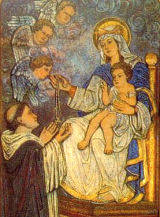

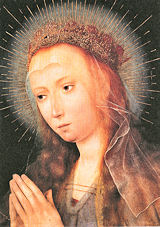
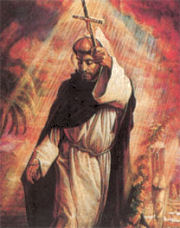 "Since the prayers of the Rosary come from such excellent sources — from Our Lord Himself, from inspired Scripture, and from the Church — it is not surprising that the Rosary is so dear to our Blessed Mother and so powerful with heaven.
"Since the prayers of the Rosary come from such excellent sources — from Our Lord Himself, from inspired Scripture, and from the Church — it is not surprising that the Rosary is so dear to our Blessed Mother and so powerful with heaven.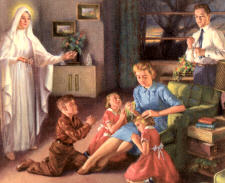 The Rosary had its origin in the liturgical mentality of former ages. Even at the present time it is called "Mary's Psalter." There still are Catholics who consider the 150 Hail Marys a substitute for the 150 psalms for those persons who neither have the time, the education, nor the opportunity to pray the Hours of the Divine Office. Thus "Mary's Psalter" is a shortened, simplified "breviary" — alongside the common Hour-prayer of the Church. — The Church's Year of Grace, Dr. Pius Parsch
The Rosary had its origin in the liturgical mentality of former ages. Even at the present time it is called "Mary's Psalter." There still are Catholics who consider the 150 Hail Marys a substitute for the 150 psalms for those persons who neither have the time, the education, nor the opportunity to pray the Hours of the Divine Office. Thus "Mary's Psalter" is a shortened, simplified "breviary" — alongside the common Hour-prayer of the Church. — The Church's Year of Grace, Dr. Pius Parsch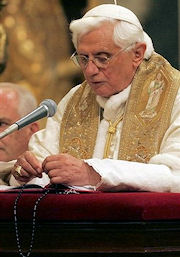 No form of extra-liturgical devotion to Mary is more widely practiced among the faithful or found by them to be more satisfyingly complete than the Rosary, which has come to be regarded as the very badge of Catholic piety. No form of extra-liturgical devotion to Mary has been recommended more warmly or frequently by the Popes. With perhaps two exceptions, all the Sovereign Pontiffs from Sixtus IV in 1478 down to John XXIII, especially Leo XIII (in 23 documents, ten of them encyclicals entirely on the Rosary) and his successors, have extolled this form of prayer, which has been the favorite, moreover, of such saints as Teresa of Avila, Francis de Sales, Louis de Montfort, Alphonsus Liguori, Don Bosco, Bernadette, and many more.
No form of extra-liturgical devotion to Mary is more widely practiced among the faithful or found by them to be more satisfyingly complete than the Rosary, which has come to be regarded as the very badge of Catholic piety. No form of extra-liturgical devotion to Mary has been recommended more warmly or frequently by the Popes. With perhaps two exceptions, all the Sovereign Pontiffs from Sixtus IV in 1478 down to John XXIII, especially Leo XIII (in 23 documents, ten of them encyclicals entirely on the Rosary) and his successors, have extolled this form of prayer, which has been the favorite, moreover, of such saints as Teresa of Avila, Francis de Sales, Louis de Montfort, Alphonsus Liguori, Don Bosco, Bernadette, and many more.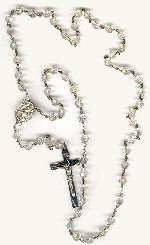 Until about the 15th century hundreds of mysteries were part of the Rosary devotion then the 15 mysteries that we know today were definitively fixed as "the Mysteries of the Rosary." Pope John Paul II, in his encyclical, Rosarium Virginis Mariae, in 2002 added the five Luminous Mysteries.
Until about the 15th century hundreds of mysteries were part of the Rosary devotion then the 15 mysteries that we know today were definitively fixed as "the Mysteries of the Rosary." Pope John Paul II, in his encyclical, Rosarium Virginis Mariae, in 2002 added the five Luminous Mysteries.

